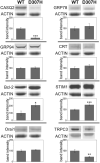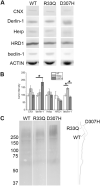Molecular adaptation to calsequestrin 2 (CASQ2) point mutations leading to catecholaminergic polymorphic ventricular tachycardia (CPVT): comparative analysis of R33Q and D307H mutants
- PMID: 32902830
- PMCID: PMC7666291
- DOI: 10.1007/s10974-020-09587-2
Molecular adaptation to calsequestrin 2 (CASQ2) point mutations leading to catecholaminergic polymorphic ventricular tachycardia (CPVT): comparative analysis of R33Q and D307H mutants
Abstract
Homozygous calsequestrin 2 (CASQ2) point mutations leads to catecholaminergic polymorphic ventricular tachycardia: a common pathogenetic feature appears to be the drastic reduction of mutant CASQ2 in spite of normal transcription. Comparative biochemical analysis of R33Q and D307H knock in mutant mice identifies different pathogenetic mechanisms for CASQ2 degradation and different molecular adaptive mechanisms. In particular, each CASQ2 point mutation evokes specific adaptive cellular and molecular processes in each of the four adaptive pathways investigated. Thus, similar clinical phenotypes and identical cellular mechanism for cardiac arrhythmia might imply different molecular adaptive mechanisms.
Keywords: CASQ2 mutations; Cathecolaminergic polymorphic ventricular tachycardia; Degradative pathways; Small heat shock proteins.
Conflict of interest statement
The authors declare that they have no conflict of interest.
Figures



Similar articles
-
Post-natal heart adaptation in a knock-in mouse model of calsequestrin 2-linked recessive catecholaminergic polymorphic ventricular tachycardia.Exp Cell Res. 2014 Feb 15;321(2):178-89. doi: 10.1016/j.yexcr.2013.12.014. Epub 2013 Dec 24. Exp Cell Res. 2014. PMID: 24370574
-
Abnormal calcium signaling and sudden cardiac death associated with mutation of calsequestrin.Circ Res. 2004 Mar 5;94(4):471-7. doi: 10.1161/01.RES.0000115944.10681.EB. Epub 2004 Jan 8. Circ Res. 2004. PMID: 14715535
-
Single delivery of an adeno-associated viral construct to transfer the CASQ2 gene to knock-in mice affected by catecholaminergic polymorphic ventricular tachycardia is able to cure the disease from birth to advanced age.Circulation. 2014 Jun 24;129(25):2673-81. doi: 10.1161/CIRCULATIONAHA.113.006901. Epub 2014 Jun 2. Circulation. 2014. PMID: 24888331
-
Calsequestrin mutations and catecholaminergic polymorphic ventricular tachycardia.Pediatr Cardiol. 2012 Aug;33(6):959-67. doi: 10.1007/s00246-012-0256-1. Epub 2012 Mar 16. Pediatr Cardiol. 2012. PMID: 22421959 Free PMC article. Review.
-
Calsequestrin 2 and arrhythmias.Am J Physiol Heart Circ Physiol. 2012 Mar 15;302(6):H1250-60. doi: 10.1152/ajpheart.00779.2011. Epub 2011 Dec 23. Am J Physiol Heart Circ Physiol. 2012. PMID: 22198169 Free PMC article. Review.
Cited by
-
Comprehensive Analysis of Key Endoplasmic Reticulum Stress-Related Genes and Immune Infiltrates in Stanford Type A Aortic Dissection.Anatol J Cardiol. 2024 Mar 6;28(5):236-44. doi: 10.14744/AnatolJCardiol.2024.4251. Online ahead of print. Anatol J Cardiol. 2024. PMID: 38445624 Free PMC article.
-
Clinical Characteristics, Genetic Findings and Arrhythmic Outcomes of Patients with Catecholaminergic Polymorphic Ventricular Tachycardia from China: A Systematic Review.Life (Basel). 2022 Jul 22;12(8):1104. doi: 10.3390/life12081104. Life (Basel). 2022. PMID: 35892906 Free PMC article. Review.
-
Molecular Pathways and Animal Models of Arrhythmias.Adv Exp Med Biol. 2024;1441:1057-1090. doi: 10.1007/978-3-031-44087-8_67. Adv Exp Med Biol. 2024. PMID: 38884769
-
The Structural-Functional Crosstalk of the Calsequestrin System: Insights and Pathological Implications.Biomolecules. 2023 Nov 23;13(12):1693. doi: 10.3390/biom13121693. Biomolecules. 2023. PMID: 38136565 Free PMC article. Review.
-
Pediatric Catecholaminergic Polymorphic Ventricular Tachycardia: A Translational Perspective for the Clinician-Scientist.Int J Mol Sci. 2021 Aug 27;22(17):9293. doi: 10.3390/ijms22179293. Int J Mol Sci. 2021. PMID: 34502196 Free PMC article. Review.
References
-
- Al-Hassnan ZN, Tulbah S, Al-Manea W, Al-Fayyadh M. The phenotype of a CASQ2 mutation in a Saudi family with catecholaminergic polymorphic ventricular tachycardia. Pacing Clin Electrophysiol. 2013;36:e140–e142. - PubMed
-
- Bakthisaran R, Tangirala R, Rao CM. Small heat shock proteins: Role in cellular functions and pathology. Biochim Biophys Acta. 2015;1854:291–319. - PubMed
-
- Bonilla IM, Belevych A, Baine S, Stepanov A, Mezache L, Bodnar T, Liu B, Volpe P, Priori SG, Weisleder N, Sakuta G, Carnes CA, Radwanski PB, Veeraraghavan R, Gyorke S. Enhancement of cardiac store operated calcium entry (SOCE) within novel intercalated disk microdomains in arrhythmic disease. Sci Rep. 2019;9(1):10179. - PMC - PubMed
-
- Brundel BJ, Henning RH, Ke L, van Gelder IC, Crijns HJ, Kampinga HH. Heat shock protein upregulation protects against pacinginduced myolysis in HL-1 atrial myocytes and in human atrial fibrillation. J Mol Cell Cardiol. 2006;41:555–562. - PubMed
-
- Bullard B, Ferguson C, Minajeva A, Leake MC, Gautel M, Labeit D, Ding L, Labeit S, Horwitz J, Leonard KR, Linke WA. Association of the chaperone alphaB-crystallin with titin in heart muscle. J Biol Chem. 2004;279:7917–7924. - PubMed
Publication types
MeSH terms
Substances
LinkOut - more resources
Full Text Sources

